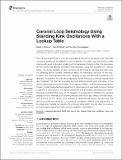Coronal loop seismology using standing kink oscillations with a lookup table
Abstract
The transverse structure of coronal loops plays a key role in the physics but the small transverse scales can be difficult to observe directly. For wider loops the density profile may be estimated by forward modelling of the transverse intensity profile. The transverse density profile may also be estimated seismologically using kink oscillations in coronal loops. The strong damping of kink oscillations is attributed to resonant absorption and the damping profile contains information about the transverse structure of the loop. However, the analytical descriptions for damping by resonant absorption presently only describe the behaviour for thin inhomogeneous layers. Previous numerical studies have demonstrated that this thin boundary approximation produces poor estimates of the damping behaviour in loops with wider inhomogeneous layers. Both the seismological and forward modelling approaches suggest loops have a range of layer widths and so there is a need for a description of the damping behaviour that accurately describes such loops. We perform a parametric study of the damping of standing kink oscillations by resonant absorption for a wide range of inhomogeneous layer widths and density contrast ratios, with a focus on the values most relevant to observational cases. We describe the damping profile produced by our numerical simulations without prior assumption of its shape and compile our results into a lookup table which may be used to produce accurate seismological estimates for kink oscillation observations.
Citation
Pascoe , D J , Hood , A W & Van Doorsselaere , T 2019 , ' Coronal loop seismology using standing kink oscillations with a lookup table ' , Frontiers in Astronomy and Space Sciences , vol. 6 , 22 . https://doi.org/10.3389/fspas.2019.00022
Publication
Frontiers in Astronomy and Space Sciences
Status
Peer reviewed
ISSN
2296-987XType
Journal article
Description
AH acknowledges funding from the Science and Technology Facilities Council (UK) through the consolidated grant ST/N000609/1. DP and TVD were supported by the GOA-2015-014 (KU Leuven) and the European Research Council (ERC) under the European Union's Horizon 2020 research and innovation programme (grant agreement No. 724326).Collections
Items in the St Andrews Research Repository are protected by copyright, with all rights reserved, unless otherwise indicated.

